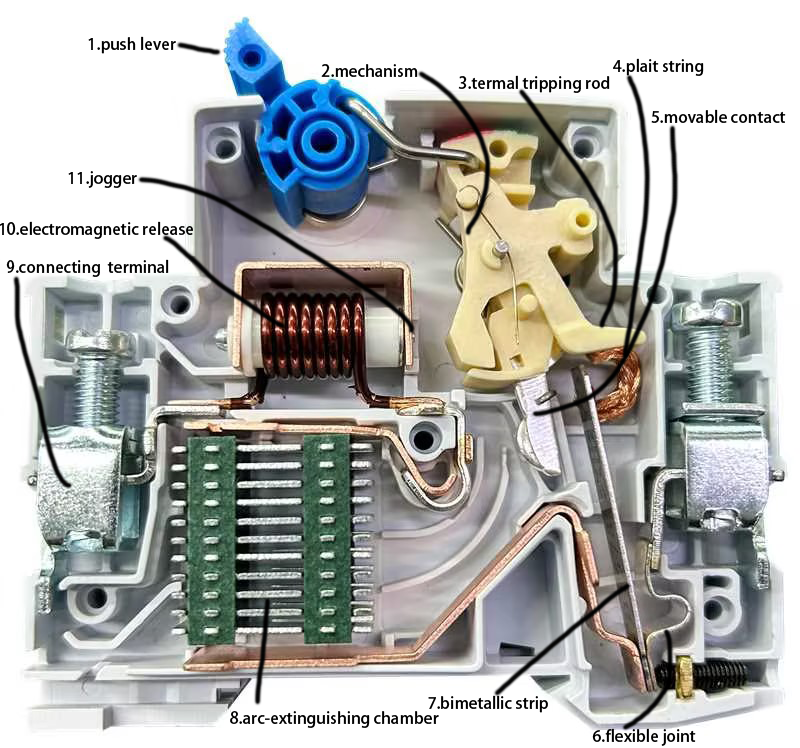
What is the DC Circuit Breaker?
How Does a DC Circuit Breaker Work?
What Are The 3 Types of DC Breakers?
In an era where renewable energy systems, electric vehicles, and advanced electronics dominate technological advancements, DC circuit breakers have emerged as critical components for safety and efficiency. Unlike their AC counterparts, direct current circuit breakers face unique challenges due to the absence of natural current zero crossings. This article demystifies their operation, explores dc miniature circuit breaker designs, and answers pressing questions like “Can AC MCB Be Used in DC Systems?”
A DC circuit breaker is a specialized device designed to interrupt direct current (DC) flow in a circuit during overloads, short circuits, or faults. Unlike alternating current (AC), DC lacks periodic zero points, making arc extinction more complex. This necessitates robust engineering in dc voltage circuit breaker systems, particularly in high-power applications like solar farms or battery storage.
Arc chutes: Engineered to stretch and cool electrical arcs.
Trip units: Detect anomalies and trigger disconnection.
Contacts: Made from durable materials like silver-nickel alloys to withstand arcing.

The operation of a dc current circuit breaker hinges on rapid arc suppression. When a fault occurs, the breaker’s contacts separate, creating an arc. In DC systems, this arc sustains unless actively extinguished. Modern dc circuit breakers for solar employ techniques such as:
Forced commutation: Using capacitors or inductors to create artificial current zeros.
Magnetic blowouts: Applying magnetic fields to disperse the arc.
Hybrid designs: Combining mechanical and solid-state components for faster response.

For example, a dc mini circuit breaker in residential solar setups may use magnetic blowouts, while industrial breaker DC systems leverage hybrid technologies.
Use bimetallic strips for overloads and electromagnetic coils for short circuits.
Ideal for low-voltage dc miniature circuit breaker setups.
Employ semiconductors like IGBTs for ultra-fast switching.
Common in electric vehicle charging stations.
Merge mechanical and solid-state elements.
Dominant in high-voltage dc circuit breaking for grid-scale renewables.

Direct current flows unidirectionally, unlike AC’s oscillating flow. Common DC sources include batteries, solar panels, and fuel cells. This unidirectional nature demands specialized protection devices, as traditional AC MCBs fail to quench DC arcs effectively.
Voltage Rating: Match the breaker’s dc voltage circuit breaker rating to your system’s maximum voltage.
Current Capacity: Ensure it handles both steady-state and surge currents.
Breaking Capacity: Critical for high-fault scenarios (e.g., dc circuit breakers for solar farms).
Environmental Conditions: Opt for IP-rated dc mini circuit breakers in humid or dusty environments.
Certifications: Look for IEC 60947-2 or UL 489 compliance.
Solar Power Systems: Protecting panels, inverters, and batteries.
Electric Vehicles (EVs): Safeguarding battery packs and charging ports.
Telecom Towers: Ensuring reliable power in remote locations.
Marine and RV Systems: Managing 12V/24V DC setups.
A recurring question—“Can AC MCB Be Used in DC Systems?”—stems from cost-saving motives. The answer is a resounding no. AC miniature circuit breakers lack arc-quenching mechanisms suited for DC’s sustained arcs. Using them risks equipment damage, fires, and compliance violations. Always deploy dc miniature circuit breaker units specifically rated for DC.
| Feature | AC MCB | DC MCB |
|---|---|---|
| Arc Suppression | Relies on natural current zero-crossing | Uses magnetic blowouts or splitter plates |
| Voltage Rating | 230V–440V (single/three-phase) | 12V–1500V (common for solar/batteries) |
| Applications | Homes, offices, HVAC systems | Solar farms, EV chargers, telecom towers |
| Certification | IEC 60898-1 | IEC 60947-2 |
| Cost | Lower | 20–30% higher due to specialized design |
Using an AC circuit breaker in a DC system can lead to inadequate interruption of fault currents, potential damage to the breaker and the circuit, and significant safety risks. Therefore, it's essential to use the correct type of breaker for the system in question
Learn More:
Why we can't use AC circuit breaker for DC?
Laiwo electrical is a one-stop solution for all your electrical needs including mcb, rcbo ,distribution boxes, surge protectors, earth leakage protection devices and switched sockets. If you have additional questions or need assistance, please feel free to contact the customer service team. Give us a call and we'll have a team of professionals answer your questions!
INQUIRY NOW